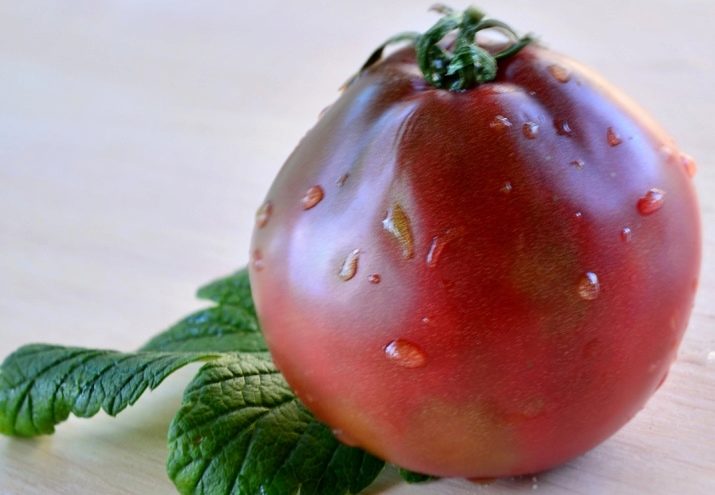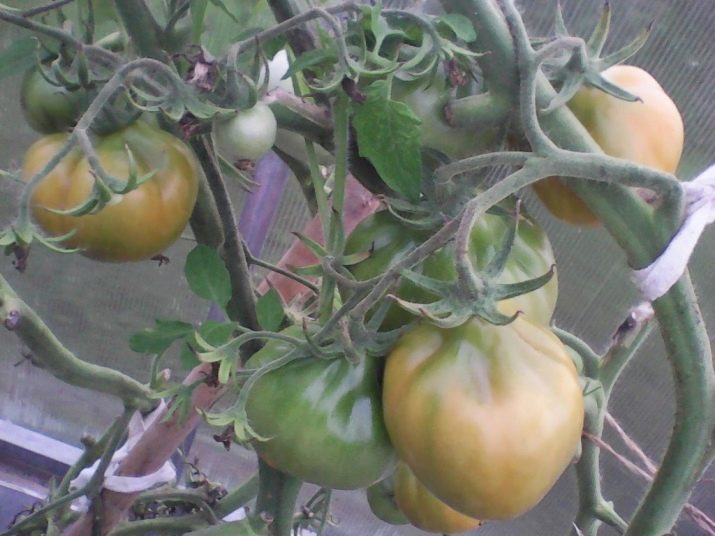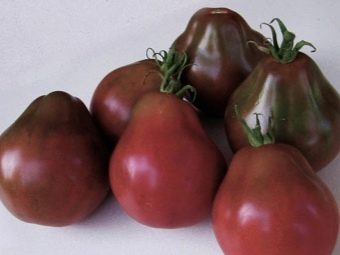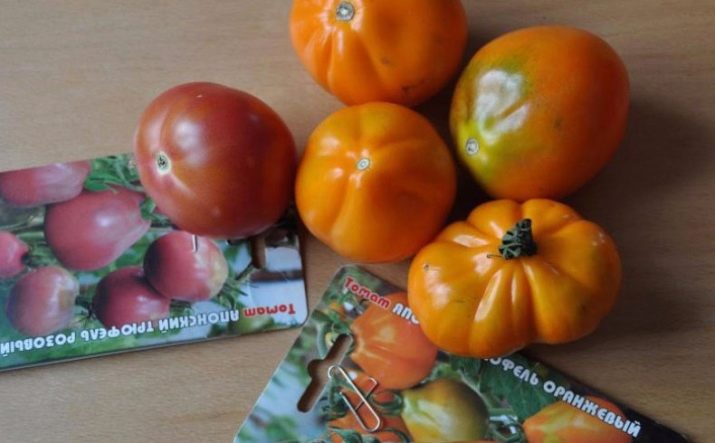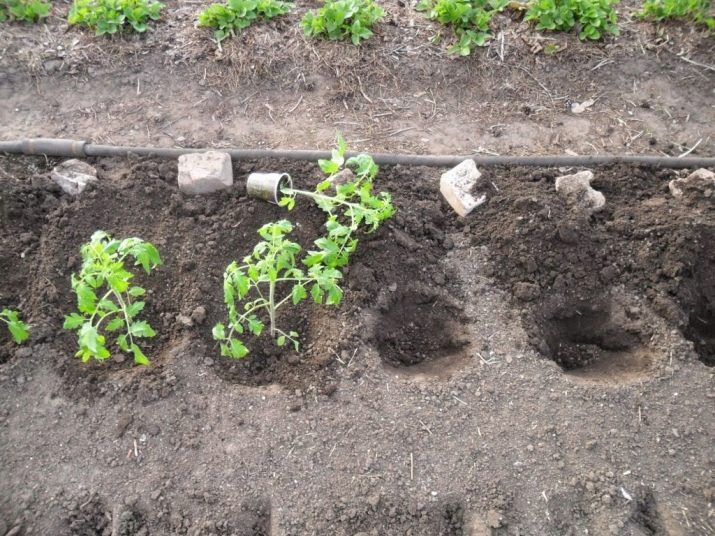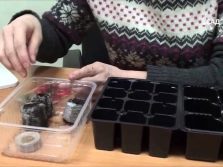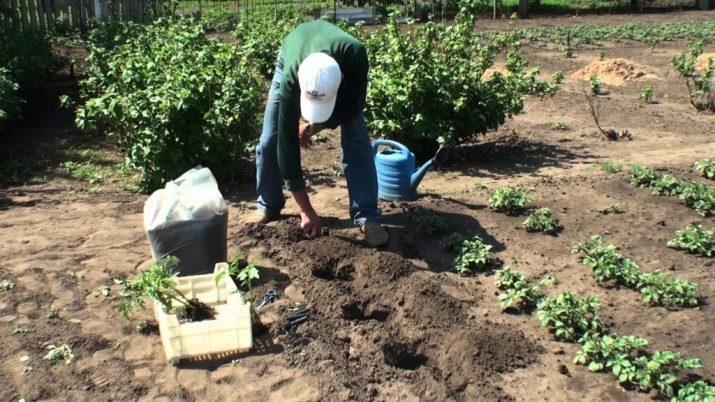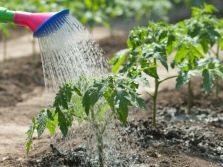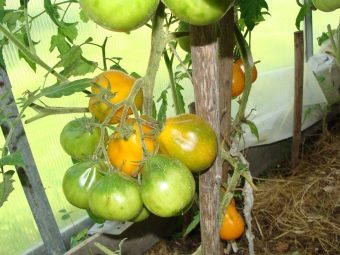Japanese truffle tomato: variety description and cultivation process
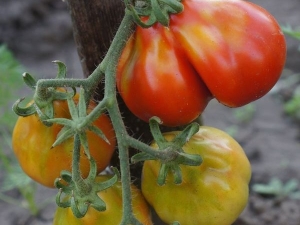
When someone hears the name "Japanese truffle", then an expensive delicacy comes to mind, although in fact it is a tomato.And although tomatoes of this variety were bred by gardeners relatively recently, this variety is already widely represented on the market. Maybe someone even managed to taste it. This article discusses the characteristics of this variety, especially the cultivation and care of it.
Special features
Tomato "Japanese truffle" - a novice in the gardens of Russia and neighboring countries. And although Western experts consider him the birthplace of the Russian Federation, local gardeners are just beginning to popularize it. Today, tomato increasingly begins to appear in the markets and garden stores. It is difficult to pass by it, because the seeds attract attention with at least their interesting name.
Such an unusual name tomato "Japanese truffle" deserved thanks to a non-standard form of the fruit. It has an elongated tail and looks like a medium-sized pear or the most ordinary light bulb. But not only its unusual appearance is remarkable. This culture is sredneranny, has no restrictions in growth. It is grown mainly in open field.
The main plus of the fruit is dense pulp with a small amount of liquid, so these tomatoes are best suited for preservation. Their significant disadvantage is small size and low yield. Therefore, you need to count the number of shrubs or immediately focus on a small crop.
Characteristic
These "truffle" tomatoes have many features. Their understanding of the gardener is important for proper care and achievement of high yields.
Bushes
“Japanese truffle” is an indeterminate variety, that is, it has no growth restrictions. On average, the plant reaches a height of 2 meters, so be sure to have supports and garters, so that the bush does not break. A tomato grows not only upwards, but also in breadth, and this process is already possible and even needs to be controlled. The best result is obtained with the development of only 2-3 shrub stalks. Usually leave the largest branches, and the rest are cut off.
Fruit
Different varieties of the variety differ in the color of the fruit, which can be red, black, orange, crimson and gold. Each tomato has a weight of about 150-200 g, that is, in general, they cannot be called large-sized. All subspecies differ from each other in taste and technical qualities.
Red tomato - the most popular and affordable form. It has a small size, up to 5 centimeters in diameter. The main features - a sweetish taste and ability for long-term storage. Most often such grade is used for preservation. It seems to be created for pickling and pickling. But also in fresh form, for example, in salads, red “truffle” will also look good.
Black Tomatoes has conquered the market due to its unusual appearance and taste. He also receives a lot more positive reviews due to higher yields compared to other subspecies of "Truffle". It is stored less than a red tomato, but it is used in fresh salads and other dishes and has a sweet taste.
Yellow "truffle" (in another way it is called "golden"), stands out with a bright color and almost fruit taste. It looks juicy and colorful in any dish. An excellent option would be the preparation of adzhika from the "golden" tomatoes.
Another variety is an orange tomato. In terms of quality, it is similar to a red tomato, but it is distinguished by its sunny, rich yellow-red color.
Raspberry "Japanese truffle" also has little special characteristics, except for a pleasant pinkish-raspberry shade.
Each of the described subspecies has distinctive features, both external and flavoring, so the choice depends on the preferences of the gardener. But do not forget that they differ in the requirements for care, albeit only slightly.
If the plot allows, it is better to plant tomato seedlings of several subspecies at once. So in practice, the "favorite" will be determined or it will be possible to mix the colors and tastes of tomatoes in different recipes.
Landing
The “Japanese Truffle” shrub doesn’t like too cold temperatures, even though the variety’s appearance is Russia. In climatic zones, where cold winters and hot summers, tomatoes grow and develop well in open ground. But if the area is always cool, greenhouse is used to protect the plant and the future crop from the cold.
Most often, this tomato is planted in the garden seedlings, which is inherent in almost any tomato culture. But before planting in the ground bush must go through several stages. Sowing should begin in early March, if you plan to transplant seedlings to the site in May. If a greenhouse is used, the landing dates are shifted a month earlier.
Works are carried out in several stages.
- Selection of seeds. In this matter, it is important to purchase planting material in proven stores. Seeds must have a quarantine pass and meet all government requirements. This is a guarantee that the summer resident will not receive the seeds of another vegetable crop. By the way, this advice applies to any plant.
- Sowing seeds in pots. For this, small containers are selected and the soil is prepared. The ideal ratio of the substrate: 2 parts of sod land plus 2 parts of humus or manure with the addition of sifted sand. This is the best base for sowing seeds. It provides the necessary level of nutrients and minerals. The depth of the hole - up to two centimeters. Falling asleep seed earth should not be pressed, on the contrary, you must leave the possibility of the future plant to "breathe" freely. Immediately after planting, cover the pot with glass or plastic wrap for several days. This imitation of the greenhouse will help to quickly get shoots. In order not to develop a fungus, the shelter changes daily, and immediately after the appearance of the sprouts is finally removed.
- Care for seedlings. To sprout and began to actively grow, the pot is placed in a warm room (the temperature is not lower than 16 degrees). A prerequisite is the absence of strong winds and drafts. As soon as the first large sheets appear, a pick is carried out. This is the process of transplanting young shoots in boxes with a fresh mixture of soil with humus. Thus, the development of the root system is stimulated. The entire period of germination should be watered regularly, but do not flood the plant so that the roots do not rot.
- Preparing the soil for planting. While “Japanese truffles” are growing on the windowsill, it's time to prepare the beds for planting seedlings in open ground. This can usually be done in mid-May, as long as night frosts end. An important, but unfortunately, often overlooked procedure is fertilization of the soil with minerals. Here you can use both chemicals and natural fertilizers.
- Acclimatization of seedlings before planting. In this matter, everything is quite simple. When the plant grows sufficiently and several leaves appear, the drawers begin to carry out on the balcony so that the tomatoes can wean away from the greenhouse conditions. When it gets warmer on the street, it's time to embark.
It is carried out as follows.
- A well-lit place in the shape of a square is chosen. The marked area should not go beyond 40 to 40 cm. The optimal depth of the beds - 20 cm.
- The distance between the bushes should also be about 20 cm. Even if it seems that the bushes are too far apart, you should not worry. When tomatoes grow, they will not be crowded.
- The roots of each sapling are examined and damaged areas are removed. Then they gently lay out in the hole, so that the tails of the roots do not look out. You can not be afraid and bury the escape, including the first leaves.
- It now remains to cover the tomato bush with soil and water it abundantly.
Planting plants on the site is a huge stress for the plant, so this is not the final point of care. It is mandatory to conduct regular and attentive inspection of the shrub for several weeks after disembarkation.It is important to monitor how the tomato copes with climate change and whether it has begun to grow.
In addition to sprouting tomatoes from seeds, there is the possibility of buying ready seedlings. It is better not to buy it in advance. Optimal purchase shrubs a few hours before planting. Fresh greens are much better acclimated than faded.
If the purchase did not happen on time, then you need to try to “cheer up” the seedlings with water and fertilizer spraying. The procedure of planting the purchase of seedlings does not differ from work with independently grown material.
Care
Tomatoes are very fond of water, especially they need it in the hot summer. Therefore, do not forget about regular watering, which should be done every other day or once a day. But you can not do this in the hottest hours - from 12 to 16. The result of such negligence will be burned bushes. It is better to arrange evening watering. Immediately after irrigation, it is recommended to loosen the soil to prevent the formation of a crust.
A peculiarity of care for tomatoes is pasynkovanie. This is the process of plucking additional lateral shoots. With an increase in the size of the shrub gives a lot of shoots that begin to compete with each other. As a result, the mass of shoots take nutrients from the plant that are not given to the inflorescences and fruits. To achieve good photosynthesis and obtain nutrients, only 3-4 sheets of greens at the top are enough. In order to avoid competition, weeds are removed under and around the tomato bushes.
We must not forget about fertilizers. Experienced gardeners recommend feeding tomatoes throughout the entire growth cycle with tree ash. But if there is no place to take it or as a gardener's fertilizer, natural materials do not attract, you can easily pick up chemicals. Spraying and watering with such agents is often used.
The main thing here is to disinfect the plant and the soil around it in order to prevent the proliferation of parasites and diseases.
Well, the last. As soon as fruits start to appear on the branches, it is important to tie up the stems. It is not recommended to skimp on the props, because even small fruits are a serious burden on the bush. If the stem is not strengthened in time, it can break and the tomatoes rot, before they mature. For bushes in the greenhouse additional point of care - regular airing.
Reviews
The Japanese Truffle Tomato variety deserves more and more love and positive customer reviews. This is due to the fact that it has an unusual shape and taste, as well as it makes it possible to experiment with color in summer salads. In a huge number of reviews and recommendations there is a high resistance of the culture to diseases. Although some of the diseases still do not bypass the tomato side. For example, brown rot, which affects the crop. Experts advise to spray the plant and immediately remove rotted fruit.
From the reviews can be identified and negative aspects of culture, as described earlier. This includes the small size of the fruit and, as a result, a small amount of harvest. But given this feature of the variety, it is possible to calculate in advance the necessary number of bushes of tomatoes.
Review of the Japanese Truffle Tomato variety in the next video.

